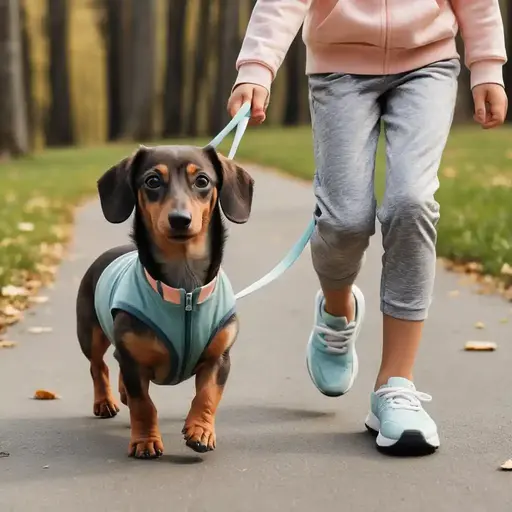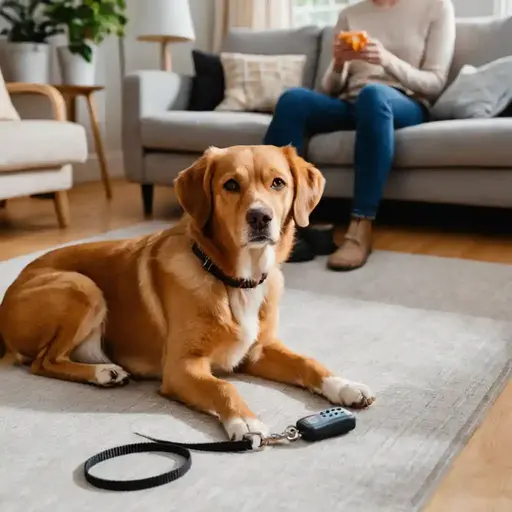Imagine a walk where your dog stays focused on you, even without a leash—no pulling, no darting after distractions.
How to Teach Your Dog to Heel Without a Leash isn’t just about control; it’s about fostering trust and clarity in your communication.
Heeling means your dog walks calmly by your side, typically on your left, matching your pace without straying.
While traditional leash training is foundational, mastering off-leash heeling elevates your bond, granting your dog freedom in open spaces while ensuring safety and responsiveness.
Off-leash training transforms walks into opportunities for connection, allowing your dog to explore without compromising obedience.
Beyond convenience, this skill strengthens reliability in public spaces, reduces anxiety in unpredictable environments, and deepens mutual trust.
Benefits of off-leash heeling include:
- Enhanced safety: Navigate parks or trails confidently, knowing your dog will stay close.
- Greater freedom: Let your dog enjoy sniffing and exploring without physical restraint.
- Sharper obedience: Reinforce focus and impulse control, which translates to better behavior in all scenarios.
This guide breaks down proven, step-by-step methods to achieve reliable off-leash heeling.
From foundational exercises to advanced proofing techniques, you’ll learn how to build a partnership rooted in attentiveness—no tugs, no tension, just teamwork.
Know more about Dog care from this free mini-course.

Prerequisites for Off-Leash Heeling
Before embarking on off-leash heeling, your dog must master foundational skills that lay the groundwork for success.
Think of it as building a house: without a sturdy foundation, even the most careful efforts can crumble.
Start by ensuring your dog has reliable obedience training in core commands like sit, stay, and come.
These aren’t just tricks—they’re the language through which you’ll communicate during off-leash moments.
A swift, consistent response to “come” is especially critical, as it could prevent a dangerous situation in open spaces.
Next, your dog should already excel at on-leash heeling. Practicing this skill with a leash reinforces focus and proximity, teaching your dog to match your pace and stay positioned by your side. Only once this is second nature should you transition to off-leash work.
Imagine it as rehearsing a dance routine until the steps feel automatic—your dog needs that muscle memory to stay connected to you without physical guidance.
Equally vital is the trust and rapport between you and your dog. Off-leash heeling relies on mutual understanding: your dog must feel confident in your leadership, and you must trust their ability to follow cues.
This bond is nurtured through positive interactions, clear communication, and patience.
Avoid rushing this phase; a dog uncomfortable with basic training environments will struggle to focus when distractions increase.
Key prerequisites include:
- Mastery of basic commands (sit, stay, come) to ensure responsiveness.
- On-leash heeling proficiency to establish focus and consistency.
- A trusting relationship is built through positive reinforcement and clear expectations.
By prioritizing these steps, you’ll create a solid framework for seamless off-leash heeling, where your dog’s obedience feels effortless and instinctive.
How to Teach Your Dog to Heel Without a Leash Training Guide
Teaching your dog to heel without a leash is a journey of patience and consistency. By blending structure with adaptability, you’ll help your dog internalize the skill naturally.
Below are two proven methods to suit different learning styles, paired with universal tips for success.
A. Tools Needed
- High-value treats: Use small, irresistible rewards like diced chicken or cheese to keep your dog motivated.
- Optional clicker: A clicker or consistent marker word (“Yes!”) helps pinpoint exact moments of success.
- Quiet environment: Start indoors or in a fenced yard to minimize distractions during early training.
B. Method 1: Lure and Reward Technique
This approach uses treats to guide your dog into position, gradually fading the lure as they learn.
Start small:
- Hold a treat in your left hand, let your dog sniff it, then position your hand against your left leg.
- Walk a few steps forward. As your dog follows the treat, say “Heel” and reward immediately after stopping.
Introduce the cue:
- Tap your left thigh as you say “Heel” to create a visual and verbal association.
- Gradually phase out holding the treat in your hand, replacing it with praise or a clicker marker.
Build complexity:
- Practice turns, stops, and speed changes. Reward your dog for staying aligned.
- Transition to outdoor spaces, starting with short, focused sessions in a quiet park.
C. Method 2: Directed Shaping Technique
Ideal for dogs that thrive on independence, this method encourages your dog to choose to heel.
Call to position:
- Use a cheerful tone to invite your dog to your side (e.g., “Fluffy, heel!”). Reward when they align with your left leg.
Fade the prompt:
- Reduce verbal cues over time, allowing your dog to anticipate the position. Celebrate when they move into place unprompted.
Add focus exercises:
- Incorporate “Look” or “Watch Me” commands during walks to reinforce attentiveness, especially near distractions.
D. Common Tips and Tricks
- Hand positioning: Keep treats at chest level to avoid encouraging jumping or lunging.
- Consistent rewards: Use a clicker or marker word to signal success before delivering the treat, strengthening the behavior-reward link.
- Progressive challenges: Gradually introduce distractions—start with a quiet room, then move to a backyard, and finally to busier parks.
- Short sessions: Train in 5–10 minute bursts to maintain focus and enthusiasm.
By blending these methods and prioritizing positive reinforcement, you’ll build a dog that heels reliably, whether exploring a trail or navigating a crowded sidewalk.
Learn how to bond with your Dog with this free mini course.

Troubleshooting Common Issues
Even with the best-laid plans, challenges arise during off-leash heeling training. The key is to address them calmly and creatively, turning setbacks into opportunities for growth.
Below are solutions to frequent hurdles, designed to keep you and your dog moving forward.
Dog Pulling Ahead
Pulling often stems from excitement or a lack of focus. To refocus, use a cheerful “Heel!” cue paired with a treat lure near your leg.
If persistence occurs, shorten sessions to 3–5 minutes to prevent frustration.
Over time, replace the lure with praise, rewarding only when your dog checks in or slows to match your pace.
Dog Lagging Behind
A lagging dog may need more motivation. Swap low-value treats for something irresistible, like freeze-dried liver, or incorporate a favorite toy as a reward.
If boredom is the culprit, add variety: weave in playful spins, sudden stops, or changes in direction to reignite their enthusiasm.
Distractions (Other Dogs, Smells, etc.)
Distractions test even seasoned heelers. Start by practicing focus exercises in low-stimulus environments, rewarding eye contact or proximity.
Gradually introduce mild distractions—a distant squirrel, a quiet path—while using high-value treats to reinforce compliance.
If your dog lunges or fixates, calmly redirect with a cue like “Let’s go!” and reward re-engagement.
Lack of Consistency
Progress stalls without regular practice. Aim for 2–3 short sessions daily, even if only for 5 minutes.
Use everyday moments (e.g., walking to the mailbox) to reinforce heeling cues.
If your dog seems confused, revisit foundational on-leash work to rebuild confidence before resuming off-leash trials.
Pro Tip:
- Breathe through challenges: Staying calm prevents tension from affecting your dog.
- Celebrate small wins: A wagging tail during a focused 10-second heel is a victory worth rewarding.
By addressing these issues with patience and creativity, you’ll transform obstacles into milestones, paving the way for reliable off-leash teamwork.
Advanced Training and Maintenance
Mastering off-leash heeling isn’t a finish line—it’s a continuous journey of refinement.
As your dog’s skills solidify, challenge their focus and adaptability to ensure reliability in real-world scenarios. Here’s how to elevate and sustain their progress:
Heeling in Distracting Environments
Busy parks, bustling sidewalks, and chaotic playgrounds are the ultimate tests of focus.
Start by revisiting foundational skills in moderately busy areas (e.g., a quiet park corner) and reward your dog for maintaining position amid mild distractions. Gradually increase complexity:
- Use high-value treats to reinforce compliance near joggers, bicycles, or wildlife.
- Practice “emergency sits” (e.g., “Sit!” during a chaotic moment) to rebuild focus.
- Pair verbal cues with hand signals (e.g., a palm-up “stop” gesture) for clarity in noisy settings.
Practicing with Other Dogs
Social settings with other dogs refine impulse control. Begin with a trusted, calm canine companion in a controlled space, rewarding your dog for heeling past or alongside them without lunging or whining. Tips:
- Use a “Let’s go!” cue to redirect attention back to you if distractions escalate.
- Incorporate group training classes to normalize focus amid playful energy.
Long-Term Maintenance
Consistency turns heeling into a lifelong habit. Weave the skill into daily routines:
- Dedicate the first 5 minutes of every walk to focused heeling, gradually extending the duration.
- Use real-world rewards (e.g., “Heel to the mailbox, then sniff freely!”) to reinforce practicality.
- Periodically revisit training drills to sharpen responsiveness, even after mastery.
Handling Regressions
Plateaus or setbacks are normal. If your dog’s focus wanes:
- Return to basics in a quiet environment, rebuilding confidence with familiar drills.
- Shorten sessions to 3–5 minutes, prioritizing enthusiasm over duration.
- Audit your rewards—are they motivating enough for advanced challenges?
Pro Tip:
- Layer your training: Introduce unexpected twists (e.g., sudden stops, direction changes) to keep your dog engaged.
- Celebrate resilience: A dog that heels through chaos isn’t just obedient—they’re a testament to your partnership.
By embracing these strategies, you’ll nurture a dog that heels reliably, whether navigating a crowded festival or a serene trail.
Learn how to train your Dog better with this free mini course.

Safety Considerations
Off-leash freedom is a privilege, not a right—it requires careful judgment, respect for laws, and unwavering attention to your dog’s behavior.
Prioritizing safety ensures that trust-building walks don’t turn into risky situations.
When to Go Off-Leash
Not every environment is suitable for unleashed exploration. Reserve off-leash heeling for secure, enclosed spaces (e.g., fenced yards or empty fields) or areas where your dog has proven recall reliability.
Avoid busy roads, wildlife-heavy zones, or crowded parks until your dog consistently ignores distractions.
Even in safe spaces, stay vigilant: a squirrel or sudden noise could trigger a chase instinct.
Legal and Community Responsibilities
Local leash laws exist to protect pets, people, and wildlife. Before unsnapping the leash:
- Research park regulations, neighborhood rules, and city ordinances to avoid fines or conflicts.
- Respect signage—even in dog-friendly areas, leashes may be required near playgrounds or sensitive habitats.
Ignoring these rules risks more than penalties; it jeopardizes public perception of off-leash dogs, making it harder for responsible owners to advocate for access.
Assessing Your Dog’s Readiness
A dog’s temperament determines their off-leash suitability. Ask:
- Is your dog non-aggressive? Even friendly dogs can react unpredictably to strangers or other animals.
- Do they respond to “come” or “heel” without hesitation? Reliable obedience is non-negotiable.
- Can they stay calm around triggers like bicycles, loud noises, or other dogs?
If your dog displays fear, aggression, or overexcitement, prioritize on-leash training or consult a professional before advancing.
Safety Checklist:
- Always carry a leash for emergencies.
- Use high-visibility gear (e.g., reflective collars) in low-light conditions.
- Avoid off-leash walks during extreme weather or near hazards like cliffs or rivers.
By balancing your dog’s capabilities with environmental and legal awareness, you’ll foster a safe, joyful off-leash experience—one that respects both your bond and the community.
Unique Angles and Additional Tips
While heel training is often framed as a practical skill, its deeper layers reveal surprising benefits for both dogs and owners.
By tailoring methods to your dog’s unique needs and personality, you’ll unlock a richer, more rewarding experience.
Adapting Training for Specific Breeds and Sizes
One size doesn’t fit all in heeling. A Chihuahua’s tiny stride, for instance, requires shorter, slower steps to keep pace, while a Border Collie’s energy demands frequent direction changes to prevent boredom.
- Small dogs: Use smaller treat pieces and adjust your walking speed to match their natural gait.
- High-energy breeds: Incorporate bursts of play or agility drills (e.g., weaving between legs) to channel their drive constructively.
The Science Behind Positive Reinforcement
Rewards-based training isn’t just effective—it’s transformative. When you reward desired behavior with treats, praise, or play, you trigger a release of oxytocin and serotonin, neurochemicals that deepen trust and reduce stress.
This contrasts sharply with punitive methods, which can erode confidence and create anxiety.
For example, a Labrador rewarded for staying close during a squirrel sighting learns to associate focus with joy, not fear.
Fun Activities to Boost Engagement
Training thrives on joy. Try these games to keep sessions lively:
- Treat Toss & Return: Toss a treat a short distance, then call your dog back to heel before releasing them to fetch it.
- Name Game: Reward your dog every time they glance at you during a walk, reinforcing their “check-in” instinct.
- Agility Heeling: Add cones or low hurdles to practice precise footwork, ideal for active breeds.
Psychological Benefits of Healing
The act of heeling is more than obedience—it’s a mindfulness practice for dogs. The focused attention required during healing can:
- Build trust: Consistent, positive interactions strengthen the human-dog bond, fostering security.
- Reduce anxiety: Structured heeling sessions provide predictable routines, calming dogs prone to overstimulation.
- Sharpen focus: Dogs learn to filter out distractions, improving impulse control in other areas of life.
For owners, the rhythmic, collaborative nature of heeling becomes a form of active meditation, lowering stress and enhancing connection.
Pro Tip:
- Track progress creatively: Use a sticker chart or app to log healing milestones, celebrating improvements like “5 seconds of eye contact” or “heeling past three distractions.”
By embracing these tailored strategies, you’ll transform healing from a chore into a cornerstone of mutual growth, where every step strengthens trust, sharpens minds, and sparks joy.

FAQ
At what age can I start teaching heel?
Puppies as young as 8 weeks can learn foundational skills like eye contact and short-distance focus.
However, advanced off-leash heeling typically suits dogs over 6 months old, once they’ve mastered basic obedience and impulse control.
Think of it as teaching a child to crawl before they run—patience ensures a stronger foundation.
Is off-leash heeling suitable for all dogs?
While most dogs can learn, success hinges on temperament and training.
Dogs with reliable recall (responding to “come” 99% of the time) and no aggression or reactivity are ideal candidates.
Nervous or overly excitable dogs may need gradual exposure to build confidence.
What if my dog is reactive or aggressive?
Safety comes first. Reactive dogs require specialized guidance to address triggers before off-leash work.
Consult a certified trainer to create a behavior modification plan—forcing the issue risks reinforcing negative patterns.
Can I teach heel without treats?
Absolutely. While treats are highly effective, praise, toys, or play (e.g., a game of tug after a successful heel) also work.
The key is consistency: reward desired behavior within seconds to reinforce the connection.
Bonus Insight:
- For puppies: Keep sessions playful—end each practice with a reward-based game to nurture enthusiasm.
- For toy-driven dogs: Use a squeaky toy as a “moving reward” during heeling to sustain engagement.
By addressing these questions, you’ll navigate challenges with confidence, ensuring training remains a joyful, inclusive experience for every dog.
Conclusion
Teaching your dog to heel without a leash isn’t just about obedience—it’s about crafting a partnership built on trust, communication, and shared joy.
From mastering foundational skills like reliable recall to navigating distractions with confidence, this journey transforms walks into opportunities for connection.
Key Takeaways:
- Start with purpose: Build a strong foundation with on-leash heeling and basic commands.
- Adapt and grow: Use luring, shaping, or games to suit your dog’s personality.
- Troubleshoot with patience: Regressions and challenges are normal—address them with calm consistency.
The rewards extend far beyond safer strolls. A dog that heels reliably becomes a calmer, more focused companion, whether navigating crowded trails or quiet neighborhoods.
This skill deepens your bond, fosters mutual respect, and grants your dog the freedom to explore while staying secure.
Your Next Step:
- Commit to short, daily practice sessions—progress is cumulative.
- Celebrate small victories, like a focused 10-second heel or a successful recall in a park.
Remember, every step forward is a testament to your dedication. With time, patience, and the strategies outlined here, you’ll unlock the freedom of off-leash adventures and the quiet pride of a dog that chooses to walk with you, not just beside you.



